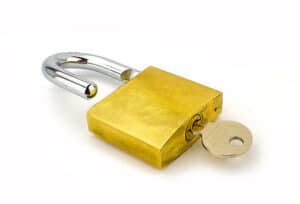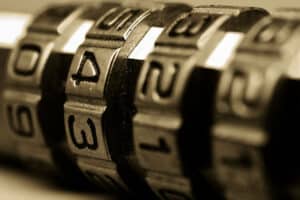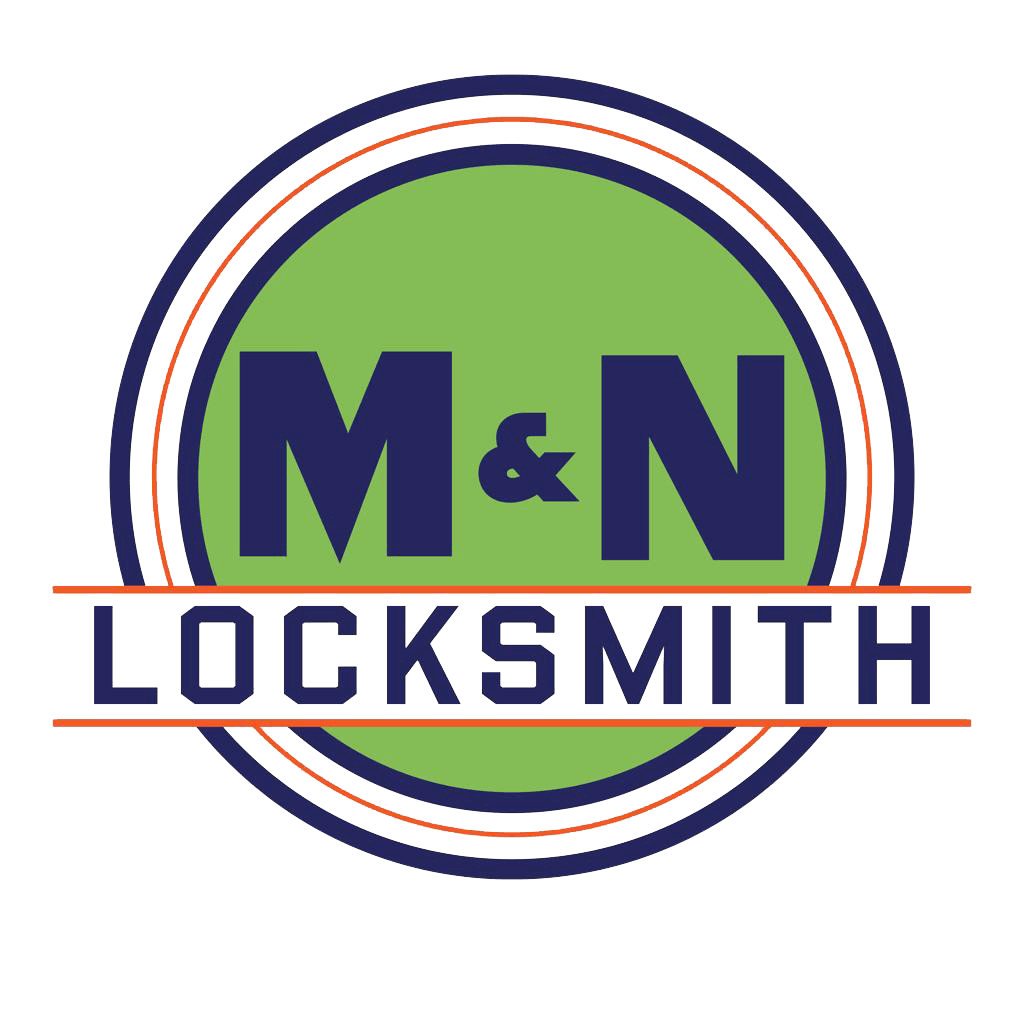- History
- Different Types
- Common Uses
- Selection
- Features To Consider
- Maintenance Tips
- The Role of a Professional Locksmith
What is a Padlock? How Does it Work?
A shackle made up of metal or U-shaped pieces along with its body forms a portable lock called a padlock. The body contains the locking mechanism which holds the shackle in place so that with the correct key or combination it can be removed.How Does a Padlock Work?
The function of a padlock relies on its type. For example, key-operated padlocks need to have actual physical keys while combination ones are opened using numbers or symbols. In addition, electronics use biometrics or utilize advanced technology such as Bluetooth connectivity for access. These types notwithstanding, all pads are designed to guarantee safety by preventing unauthorized access.History
Padlocks have been around for thousands of years; you can trace their origins back to ancient Egypt, Greece, and Rome where they were first known to have been used. These early forms were usually wooden or bronze constructed with simple mechanisms that provided some level of security for their shackles. Over time, the design evolved with each culture having its unique innovation. The 18th century came with the Industrial Revolution which saw significant advancements in lock-making technology consequently leading to mass production involving cheap prices thus available even to ordinary people at low prices. Padlocks became more effective against picking due to improved materials and manufacturing techniques Nowadays, from securing school lockers to shielding valuables in warehouses, padlocks are extensively used in different industries and setups. They have become an integral part of our daily routine ensuring safety as well as security of our property.Common Uses of Padlocks
Padlocks have a wide range of applications and can be found in various settings. Some examples of padlock uses include:Residential Security
Padlocks can be used to secure gates, sheds, and other outdoor storage units thereby enhancing the safety in your place.Bicycle Locks
Many bicycles are protected using padlocks when not being ridden. The right kind of lock will help discourage theft and keep your bicycle safe.
Luggage Locks
Padlocks are necessary for securing luggage while on a journey; they minimize chances that unauthorized persons might access your belongings thus giving you peace throughout the trip.Security Locker
The use of padlocks is common in most schools especially gyms and offices where they are meant to safeguard individual’s personal effects hence providing convenience for all users.Vehicle Padlock
Some padlocks are designed purposely to protect vehicles like trailers or motorbikes which offer more resistance against any unauthorized entry or theft. Given their adaptability and broad range of applications, one can see why padlocks have grown into an invaluable asset for securing our possessions in a variety of circumstances.Types Of Padlocks
Varieties of padlocks have unique characteristics and benefits. Let us now focus on the three types of padlocks that are common: “key-operated padlocks, combination padlocks, and electronic padlocks."
1. Key-operated Padlocks
Key-operated locks are traditional padlock types that enjoy popular usage. They require a tangible key to open them. The key is inserted into the keyway of the lock, and then it is turned for the shackle to be liberated. Key-operated locks are widely preferred since they have proven to be simple and dependable over time and can therefore suit many different applications.

2. Combination Padlocks
Combination padlocks use numbers or symbols in combination to unlock them. By turning the dial or aligning the symbols, a user sets an exclusive code that opens up the lock when put correctly. Combination locks are adored as they do not have any keys which can easily get lost or fail to be in place.

3. Electronic Padlocks
Electronic padlock is the newest form of technology in this area of security systems such as a fingerprint scanner or Bluetooth access control system while others incorporate computer-based technology such as Bluetooth connectivity. For instance, biometric ones employ fingerprint scanning/face identification methods for unlocking purposes which give maximum protection. Smartphone apps enable unlocking these devices via bluetooth connection on one’s phone among other things.

Each type has its advantages and things you should consider before buying one including what level of security you need, ease of use, and compatibility with your specific requirements.
Choosing the Right Padlock for Your Needs
When choosing a suitable lock for your needs, always remember about the definite application requirements it will be used in. Above are some tips on choosing the correct locks for usual cases:
Padlocks for Doors
When selecting door locks based on their function doors must be secure against burglars, so we consider how resistant they should be. For outdoor entrances such as front doors choose heavy-duty models with hardened steel shackles and anti-pick features; while for indoor doors, you can buy any standard lock that has medium security.
Padlocks for Gates
Gates typically need strong locks that will survive in out-of-the-house climates and ensure firm protection. Use a combination of corrosion-resistant materials (e.g., brass or stainless steel) to build padlocks with weatherproof bodies. Consider using a shroud around the shackle for additional defense against bolt cutters and pick locks.
Padlocks for Bikes
Durability and portability should be two main factors when choosing your bicycle lock. Buy bike-specific ones such as u-lock or chain lock systems among others. You should also look for those that have high-security ratings like being resistant to cuttings or prying open, but still which are light enough to carry on bike rides.
Padlocks for Lockers
Convenience and reliability are very important when it comes to securing lockers at schools, companies, or gyms. Combination padlocks often fulfill these criteria as they do not require any keys. Look for combination locks that are robustly built with smooth turning dials reducing delays during opening.
By meeting specific needs and buying the right lock type, one can be sure about their belongings’ safety.
Features to Consider When Purchasing a Padlock
There are several critical aspects required to be considered before buying a padlock that determines its longevity, security level, resistance under certain weather conditions, etc. so that you can easily protect your items in case anything occurs. Next is an enumeration of some important things:
Durability
Padlock longevity necessitates durability against physical attacks, severe weather conditions, and daily use. For example, padlocks with tough construction like hardened steel shackles and brass bodies are available in the market. Also, take into account the lock’s durability especially its ability to withstand picking or tampering.
Level of Security
The level of security signifies how resistant the padlock is to physical attack or unauthorized access. This indicates that padlocks are classified according to their security grades such as low, medium, or high-security levels one can evaluate the type of protection they need for a particular purpose to decide on which type of padlock suits them.
Resistance to Weather Conditions
In case one intends to use these locks outdoors or in areas exposed to moisture and extreme cold then they should have resistance towards such harsh climates. One should look out for corrosion-resistance bodies, rubber seals, and protective coatings among other characteristics in selecting weather-resistant padlocks. Such attributes will guarantee long life and efficiency even when atmospheric conditions are not favorable.
By consciously considering all these factors when you go out shopping your decision will be informed hence your chosen lock will offer both reliability and safety.
Tips for Taking Care Of Your Padlock
To maintain your padlock’s lifespan it must receive regular maintenance and proper care. Below are some guidelines to follow when maintaining a padlock:
Clean It Regularly
Periodically wipe off dirt, and foreign particles using a mild detergent with a clean cloth on the surface of your padlock this helps prevent corrosion as well as keeping it smooth during opening operations plus closing operations.
Lubricate
It is good practice to lubricate moving parts like the shackle and locking mechanism by use of silicone-based lubricant which discourages rusting while maintaining efficient operation.
Avoid Excessive Force
Avoid applying excessive force or using tools to tamper with the padlock. This can damage the internal mechanisms and compromise the security of the lock.
Store Properly
When not in use, it should be stored in a secure and dry location. Extreme heat, humidity, or even direct sunlight should be avoided since they affect its performance and lifespan.
Regular Inspections
At times observe your padlock for any signs of rusting, bent shackle, and loose parts which may indicate possible damage. In case of such signs repair the lock or replace it altogether to ensure its optimum performance.
Thus you can increase the longevity of your padlock while keeping reliable operation so that you are always safe from any worries.
The Role of a Professional Locksmith during Padlock Installation and Maintenance
Although most types of padlocks are simple enough that the average person can install them, there are situations where hiring a professional locksmith comes in handy. A locksmith is trained to provide security as well as functionality through the installation, maintenance, and repairs of locks. Some instances when a locksmith can offer his services include;
Difficult Installations
If you need to fit a lock onto an unusual or difficult place then hire a professional locksmith who knows how to set up locks correctly to make them secure too.
Lock Repairs
If your padlock becomes damaged, a locksmith can assess the extent of the damage and provide the necessary repairs or replacements. This ensures the continued effectiveness of the lock and prevents potential security breaches.
Key Duplication
If you require additional keys for your padlock or need to replace a lost key, a locksmith can provide key duplication services. This saves you time and ensures the availability of spare keys when needed.
Security Consultation
If you are unsure about the best type of padlock for your specific needs or require guidance on enhancing the security of your property, a locksmith can provide professional advice and recommendations.
By engaging the services of a professional locksmith, you can ensure the proper installation, maintenance, and repair of your padlock, maximizing its security and longevity.
Conclusion
Padlocks are an essential part of our daily lives that ensure safety in different areas. Therefore, when it comes to selecting a padlock for your doors, gates, bikes, or lockers; you should be extremely careful about this decision. Always consider such factors as durability, security level, and weather resistance while choosing one. To increase the functionality and life span of your padlock regularly maintain it or in case these services are necessary always consult a professional locksmith. So let us perform some magic on padlocks, open up their potential uses, and keep our belongings out of reach!
Frequently Asked Questions
1) What is a padlock?
A Portable lock made up of shackle, body, and locking mechanism which is used to secure various items from people who know nothing about them.
2) What are the types of padlocks?
The three main kinds of padlocks include key-operated ones, combination ones, and electronic ones.
3) How do key-operated padlocks work?
Key-operated locks require the use of a physical key to unlock them. To release the shackle, insert the key into the lock’s keyway then twist it.
4) How do combination padlocks work?
Combination locks use numbers or symbols with unique sequences for unlocking purposes. These combinations can be set by users who will then have access to certain features after appropriately dialing them.
5) How do electronic padlocks work?
For access control purposes, electronic commercial-grade systems such as biometrics or Bluetooth connectivity are often employed by these devices. They offer convenience and enhanced security.
6) How do I choose between different types of locks available for my needs?
Consider several aspects including how long-lasting they are, what level of protection they provide against break-ins/ theft cases plus how long will it serve me before contacting an expert locksmith when making your choice accordingly. For example, should I go for door locks instead of gate locks, etc.. Overall, we should ensure that the padlock has high resistance to weather elements.
7) How do I maintain and care for my padlock?
Regularly clean your lock, apply lubrication, avoid excessive force, store it properly, and inspect it for any signs of damage. This will help you have a lasting service from the lock.
8) When should I consult a professional locksmith for my padlock?
Always consider involving a professional locksmith for complicated installations, repairing of locks, key duplication, or even security consultations. As such they can operate these components without compromising on how secure they are.


